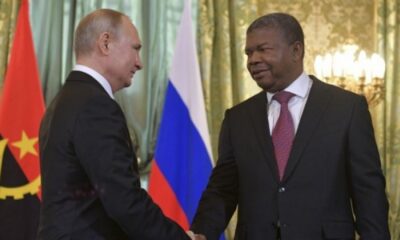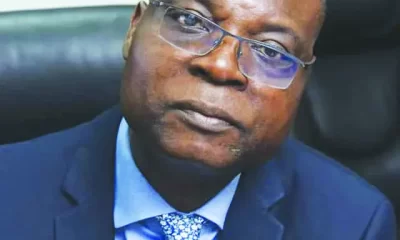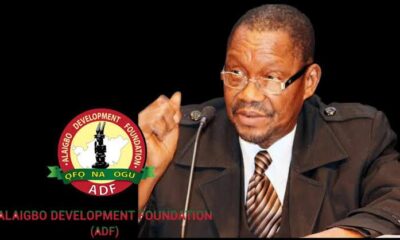National Issues
Beyond the numbers: Reflections on budget 2017 proposal -By Uchenna Uwaleke


Uchenna Uwalek
As required by the 1999 Constitution, President Muhammadu Buhari on December 14, 2016 performed a crucial aspect of the annual budget ritual when he laid before a joint session of the National Assembly the 2017 budget proposal. While Section 81 of the constitution allows the President the liberty to lay the Appropriation Bill at any time before the commencement of the next financial year, doing so in December tends to reinforce what is gradually becoming a “new normal” in fiscal year operations that is alien to our laws. By virtue of Section 318(1) of the 1999 Constitution, the financial year in Nigeria runs from January 1 to December 31. Beside the controversies that dogged the 2016 Appropriation Bill, the distortion in the 2016 financial year can be traced to the fact that the budget proposal was not submitted to the legislature for consideration until December 22, 2015.
While presenting to the public the 2017 budget proposal on December 19, 2016, the Minister of Budget and National Planning, Senator Udoma Udo-Udoma, said the proposal was based on the 2017-2019 Medium Term Fiscal Framework. How is this so? The 2017 budget proposal has an expenditure outlay of N7.298tn, oil price benchmark of $42.50 per barrel, crude oil output estimate of 2.2 million barrels per day and an average exchange rate of N305 to the dollar with aggregate revenue available to fund the federal budget at N4.94tn. But the 2017-2019 Medium Term Expenditure Framework/Fiscal Strategy Paper (which was still on the website of the Budget Office up till the time of writing) projected for 2017 a budget size of N6.87tn, oil price benchmark of $42.50 per barrel, crude oil output of 2.2 million barrels per day and an average exchange rate of N290 to the dollar on the basis of which aggregate revenue available to fund the federal budget was put at N4.17tn.
According to newspaper reports, the 2017-2019 MTEF was debated and approved by the House of Representatives on Tuesday, December 13, ahead of the President’s budget speech with an adjustment to the exchange rate from N290, which was considered unrealistic, to N350 to the dollar. The executive budget proposal eventually had N305 to the dollar. Section 18 of the Fiscal Responsibility Act 2007 provides that the Medium Term Expenditure Framework “shall be the basis for the preparation of the estimates of revenue and expenditure required to be prepared and laid before the National Assembly under Section 81 (1) of the Constitution”. Notwithstanding the provision of Section 16 of the FRA 2007 which grants the President the power to effect changes in the “fiscal indicators which in the opinion of the President are significant”, it is important for the Budget Office to clarify the version of the MTEF upon which the 2017 budget proposal is based.
Beyond the budget numbers are the vital issues of access and participation. The public needs access to budget information and opportunities to participate in the budget process. It is becoming a tradition to have the public presentation of the budget proposal done by the minister at the Banquet Hall of the Presidential Villa. A less restrictive venue such as the International Conference Centre is better suited for this purpose. Aside from government officials, professional bodies, organised Labour, organised private sector and Civil Society Organisations, the academia, students and indeed any interested member of the public should, after proper identification, be allowed access to the venue of the public presentation.
Considering that the annual budget is the key instrument by which a government translates its policies into action, global best practice recommends that this should be accessible to the public. According to the International Budget Partnership, budget information is publicly available “if it is published on an official government website”. One cannot say the 2017 Appropriation Bill already before the National Assembly is in the public domain. It is neither on the website of the Budget Office nor that of the Ministry of Budget and National Planning. In what is referred to as the “Trial Balloon”, the government of Canada releases the budget proposal to the general public prior to its official presentation to Parliament in an effort designed to gain insight on the potential public reaction to estimates in the budget. It is no surprise that Canada is one of the top 10 countries on the Transparency Open Budget Index. In this regard, Nigeria can learn from Canada.
The much that is in the public space regarding the 2017 budget is the President’s budget speech and the 18-page document containing the public presentation made by the Minister of Budget and National Planning. The difference between the two is usually in the design and information content. While the President’s speech is meant to contain highlights of the proposal, the minister’s presentation is expected to be more detailed and descriptive, employing tables and charts for maximum effect. Although fine in many respects, the budget proposal paper presented by the minister seems to fall short of these essential attributes. For example, comparative figures should have been shown in respect of Section 7.3 (especially paragraphs 23 and 24) which presented the breakdown of recurrent (non debt) expenditure as well as Section 7.7 (paragraph 30) which dwelt on the composition of infrastructural spending. Comparative data serve to provide an indication of the credibility and priorities of the budget proposal. The minor errors in the document such as omissions in sections numbering (3.1 and 7.4 omitted) as well as inconsistencies in the use of the dollar sign (US$ or $?) may be considered insignificant but should be taken note of. A budget document should have zero tolerance for errors.
As called for by international standards and especially against the backdrop of the 2016 budget experience, a statement on the fiscal risks to the 2017 budget highlighting measures to be taken to mitigate such risks would have enriched the information content of the minister’s speech leaving the detail for inclusion by way of appendix to the Appropriation Bill. This is also consistent with Section 19 of the FRA 2007 which requires that the annual budget be accompanied by a “Fiscal Risk appendix evaluating the fiscal and other related risks to the budget and specifying measures to be taken to offset the occurrence such risks”.
In line with the OECD best practice for budget transparency, a simple version of the 2017 budget proposal (a non-technical presentation known as Citizens Budget) should be made available to the public. Where possible, it should be translated into major Nigerian languages and widely disseminated using a variety of media. When produced by the government budget office other than civil society groups, it serves to institutionalise the government’s commitment to presenting its policies in a manner that is understandable by the public.
All said, the Minister of Budget and his team deserve commendation for coming up with the 2017 budget proposal barely seven months into the implementation of the 2016 budget. To provide a major opportunity for public scrutiny and civic engagement as well as facilitate a thorough interrogation of the 2017 budget estimates, the National Assembly should ensure that, like the General bills, the 2017 Appropriation Bill is subjected to public hearing. By providing a platform for open discussion on the budget, the Legislature will be helping to broaden public debate on budget priorities.


















